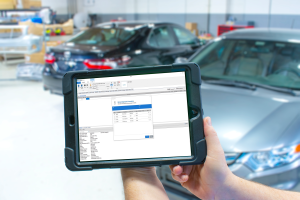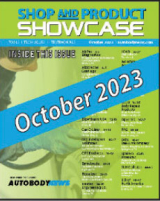Hey Toby—I was told by my alignment shop that a 2009 Toyota Camry needed to have its steering angle sensor recalibrated after the alignment. Is that true?
—Bill from Huntington Beach
Hey Bill—It is true, and the reason is somewhat involved. A little background: In 1995, Mercedes Benz introduced electronic stability control or ESC on their S class model followed shortly by BMW, Volvo and Toyota. As the safety aspects were realized, more and more of the vehicle manufacturers started to develop their own systems. At the beginning of 2011, NHTSA requires all passenger cars to be equipped with ESC.
ESC begins operation as soon as the vehicle is turned on. It continuously monitors the steering and vehicle direction. It compares the driver’s intended direction, which done by a steering wheel angle sensor, and the vehicle’s actual path (uses an acceleration yaw rate sensor (more on this later) and road wheel speeds). During normal driving, the system remains passive until it detects a loss of steering control (skidding, understeer, oversteer, or hydroplaning) as which time it “kicks in.” ESC estimates the direction of the skid and it will apply pressure to the brake system (individual wheels). The procedure will produce a torque about the vehicles vertical axis, which in turn causes the vehicle to counter the skid and bring the vehicle back to its original direction. The system can also reduce engine power or shift the transmission into a lower gear automatically.
The ESC system is dependent of a number of sensors, yaw rate sensor, steering angle sensor, wheel speed sensors and lateral acceleration sensor.
The steering wheel sensor works by counting the revolutions that the steering wheel is making and how fast and compares those numbers to a set of standards which then sends the inputs to a computer. When there is a change to those standards, the control will make adjustments and corrections to stabilize the vehicle.
The Yaw rate sensor measures the rotation rate of the car. In other words, the sensor determines how far off-axis a car is “tilting” in a turn. This information is then fed into a microcomputer that compares the data with wheel speed, steering angle and accelerator position, and, if the system senses too much yaw, the appropriate braking force is applied. The lateral acceleration sensor measures the g-force from a turn and sends that information also to the ECU. Lastly, the wheel speed sensors measures the wheel speed. Some quick notes on ESC.
First and foremost, the system is not a substitute for safe driving, but is designed to assist the driver recover from dangerous situations. ESC works on virtually any surface, for example, rain slick roads, icy roads and dry pavement. Again, ESC does not increase traction and it does not mean that a driver can drive into a curve faster, but it can help if help if a driver miscalculates his or her speed going into the curve. What the system does is saves lives and that is the major reason that by the year 2012 all vehicles will be equipped with some sort of ESC. Let’s look at the heart of the system, the steering angle sensor.
As the driver steers the vehicle, the steering angle sensor will send signals to the ECU (ABS control module). The ECU will know the direction of the vehicle’s movement and how fast the steering wheel is turning. Remember that as a vehicle goes into a curve, the tires move at different rates (the inside tire rotates at slower speed than the outside tires). In an understeer condition, traction is lost on the front wheels which in turn cause the vehicle to make a wider turn and that causes a speed difference to decrease between the right and left front wheels. In a oversteer condition, the rear wheels loose traction and the car begins to spin and the speed difference between the right and left tires to increase. The sensors send data to the stability control software (located in the ABS Control Module) which will begin to apply brake pressure to the appropriate wheels to counter the forces involved. Furthermore, the engine power is reduced and the vehicle should regain its stability.
In a four-wheel alignment the rear wheels are adjusted to achieve a zero or near zero thrust angle,before any front wheel adjustments are made All vehicles should be 4-wheel aligned. Two-wheel alignments have become obsolete because they align only the front wheels to the vehicle’s centerline. A 2-wheel alignment assumes the rear wheels are already aligned with the geometric centerline. Two-wheel alignments may a little money up front, but your vehicle’s handling and tire tread life will be compromised. Nearly all vehicle manufacturers require that the steering angle sensor be recalibrated after all 4 wheel alignments to insure proper function of the Electronic Stability Control System.









